An electric skillet is a self-contained cooking device that combines certain features of
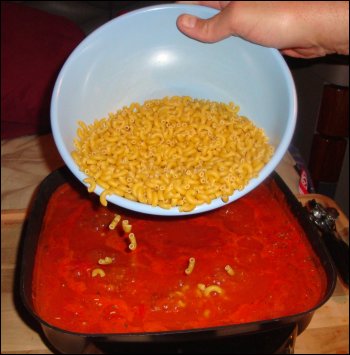 a pot with high sides and
a pot with high sides and- an electric griddle
with a temperature control that can be set to a specific temperature.
Many different foods can be cooked in one.
(The photo here shows Mike pouring elbow macaroni into a tomato base sauce in an electric skillet to make beefaroni.)
According to the description of certain electric skillets, they can be used to roast, fry, grill, stew, bake, make casseroles and more.
Unlike some other AC-powered cooking devices, most of these can be completely immersed in water for easy cleaning.
Before you buy and use such a device in your 18-wheel tractor trailer, here are some tips to bear in mind.
Shape
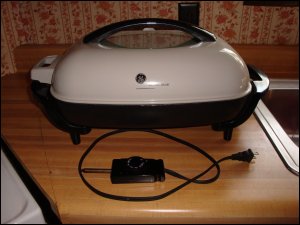 Most electric skillets are described in terms of inches:
Most electric skillets are described in terms of inches:
- one number is used for square or round units;
- two numbers (length and width) are used for rectangular units.
Mike has used a square unit with rounded edges in the trucks he has driven regionally and long haul.
When we had a residence, we use a rectangular unit with rounded edges.
Size
We have found that we can cook about twice as much ground beef in our larger rectangular unit as the smaller square unit.
If you are not concerned about cooking large amounts of food, a smaller device might work for you.
The size of your electric skillet may limit where you can store it in your truck.
The most common place where we have stored this device in a truck is under the bunk
- with the cord inside (on top of a paper towel to keep it from rattling and to protect the non-stick coating) and
- the lid on in the upright position.
Because the lid fits snugly, the unit does not rattle even on the roughest of roads.
“Even Heating”
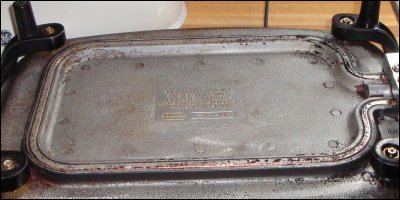 Some people claim that one of the benefits of using an electric skillet is its ability to heat foods evenly.
Some people claim that one of the benefits of using an electric skillet is its ability to heat foods evenly.
Please observe the heating element on the bottom of our large rectangular device.
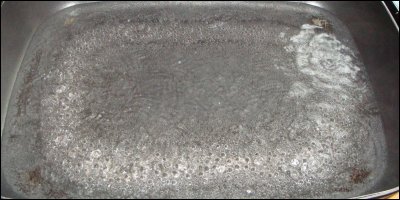 Now, please observe how water heats up in the device.
Now, please observe how water heats up in the device.
You will see that the water boils at the point where the heating element is directly below.
To us, this device does not heat as evenly as a pot does on our stove burner.
Lid
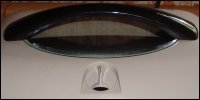 It is convenient to be able to see food while it is cooking.
It is convenient to be able to see food while it is cooking.
Some electric skillet lids have see-through tops (like the one shown here).
We seldom actually observed food cooking through the lid on this unit because of its size and location (directly under the large black handle).
Some electric skillets have all glass lids — which make it very convenient to see the food while it is cooking.
It is also convenient for the lid to include a steam vent, as the one shown here does (shown here with the vent “open”).
All glass lids may have a hole with a protective metal ring inserted.
Bear in mind the materials in the lid and its handle or knob.
- Is the lid or handle/knob made of glass, metal, plastic or wood?
- How easily can it break or chip?
- Will the foods you cook in it stain it?
- Is the handle or knob easy to grasp?
- During the course of cooking, will the handle or knob become so hot that you need to use a potholder to lift the lid?
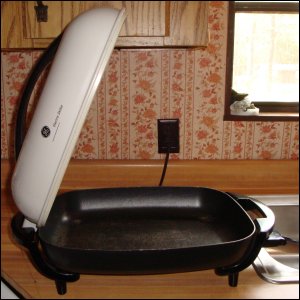 One of the biggest inconveniences in using an electric skillet is either holding the lid or finding a place to set it down during the cooking cycle.
One of the biggest inconveniences in using an electric skillet is either holding the lid or finding a place to set it down during the cooking cycle.
This could occur any time when the food within needs to be stirred.
If you need to use both hands (one to stir, one to hold the unit), you’ll need to set down the lid.
Mike’s square unit does not have a built-in lid holder, but our larger rectangular unit does.
See how the extension on the lid fits into the hole on the handle, allowing it to be propped up so that the condensation can run back into the base?
The lid on unit shown here has a “protrusion” that allows it to rest in the handle/leg.
We no longer have this unit, but Vicki does not seem to recall that the “protrusion” was any wider than the handle/leg on the unit when it was closed.
Non-stick Coating
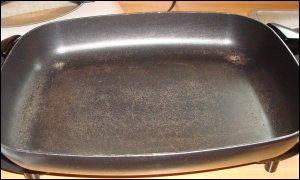
Many cooking devices these days have some form of non-stick coating.
Please observe from this photo how the non-stick coating in our large rectangular electric skillet is peeling, especially in the corners.
One of the most popular non-stick surfaces on cookware is Teflon.
You need to be aware of the health risks associated with the use of this product.
For your convenience we are providing a link to the article from Dr. Joseph Mercola (on another site) entitled “Teflon Lawsuit Slides Off DuPont.”
We do not recommend any specific alternative non-stick coating.
If you find that the coating in your electric skillet is peeling, you may choose to have a company reapply it.
Some consumers prefer a different kind of electric skillet, such as one that is ceramic.
Handles and Legs
Some AC-powered units, such as the one shown on this page, have hard plastic parts that are attached via screws to the bottom.
These plastic parts are a combination of handles and legs.
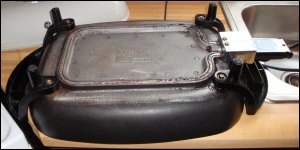 Depending on the device’s usage and the design of the handle/leg, this part can break easily.
Depending on the device’s usage and the design of the handle/leg, this part can break easily.
One day when we had only the one square electric skillet in our home, Vicki was drying it and accidentally dropped it on the floor.
One of the handles/legs broke.
The cost to replace it (with shipping) was more than she wanted to spend.
She attempted to glue it but the glue didn’t hold.
Mike eventually took that unit on the road.
It was during one of Vicki’s trips with Mike that she used duct tape to tape the two broken pieces together.
Granted, we would never want to immerse the duct tape in water, but the cheap fix worked until the unit was replaced with a new one.
There are companies that sell replacement appliance parts.
If you are intent on buying a replacement part, consider whether or not you have to buy two at a time and if this is a good value for you.
Believe it or not, we still have the second replacement handle/leg of a unit that we no longer own!
Having to buy two replacement parts for the now-discarded appliance led Vicki to just duct tape the broken handle/leg of Mike’s unit.
Special Care
You will want to follow the manufacturer’s instructions for seasoning your electric skillet.
Also, always use the right kind of utensils.
Be aware that the use of metal utensils may shorten the life of any cooking device containing a non-stick coating.
Some people prefer using nylon, melamine or silicon utensils for cooking.
It may also be easier if you to buy a set of utensils all made of the same material.
Please do your own due diligence before buying utensils.
The following link is from Amazon.com, with whom we have an affiliate relationship.
Power Requirements
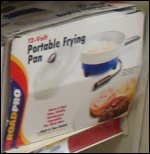 Of particular importance to professional truck drivers is the amount of energy required to operate your electric skillet.
Of particular importance to professional truck drivers is the amount of energy required to operate your electric skillet.
While there are some 12-volt devices on the market, we do not recommend them for the same reasons we outlined on our Pot-n-Pop page.
We believe you would be better served buying an AC-powered unit plugged into your inverter.
However, make sure that the energy it draws is no more than what the inverter can provide.
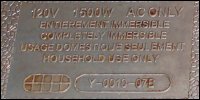 This image shows that our large rectangular electric skillet draws 1500 watts.
This image shows that our large rectangular electric skillet draws 1500 watts.
(See “1500W” on the top line in the middle.)
Since we used a 1500 watt inverter in the trucks we lived in, we used this device in our trucks.
Our Experience
We have used this type of electric skillet for years.
Mike has always enjoyed using an electric skillet in his truck for cooking certain foods like these:
- scrambled eggs;
- grilled cheese sandwiches;
- freshly prepared pizza (using a pizza crust mix and adding the toppings of his choice);
- warming up pre-cooked bacon; and
- warming up foods prepared by his home support team.
Of all the cooking devices in his truck, he used an electric skillet about 10% of the time.
He used to mostly use a microwave oven, but switched to using his Kitchen Kettle hot pot the most.
For more on these appliances, please see our meal preparation page.
Clean Up
Unless the food that you’re preparing in your electric skillet is fairly dry, clean up can be a real challenge.
For example, getting rid of grease run-off, such as that from a grill can be especially challenging.
You’ll want to be prepared with the right tools for the job.
![]() Money saving tip: Consider the foods that you will be cooking to determine which device can fix it faster or more easily.
Money saving tip: Consider the foods that you will be cooking to determine which device can fix it faster or more easily.
Instead of using any appliance with a 12-volt plug in a truck, we recommend using a standard AC-powered appliance plugged into a battery-connected inverter.
Compare the features of the devices you are considering, including their warranties.
You do not want to buy a device that is too big or too small to meet your needs.
Look carefully at the design of the units you’re considering, to see if they will hold up to the rigors of life on the road.
A sturdier unit, though more expensive up front, may be a better investment over time.
Return from Using an Electric Skillet to Cook Meals in Your Tractor Trailer to our Meal Preparation page or our Truck Drivers Money Saving Tips home page.







